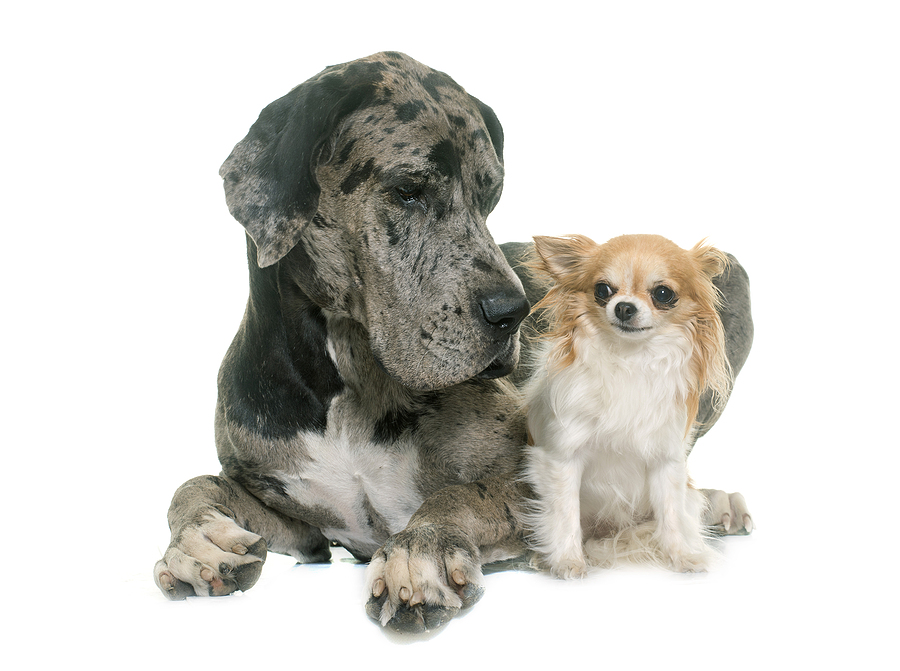My 80-pound Labrador, Logan, was quivering in excitement to meet his new little brother. “Little” was not an exaggeration. My new Papillon puppy, Finian, weighed a scant 1.2 pounds. Was the size difference between the two a big deal? Yes! Planning ahead, I had prepared everything for a safe, positive introduction.
I sat on the couch with Finian in my lap, which put him at about Logan’s height. My friend Jenny was with me to manage Logan should he get too excited. Logan was well trained, but he was so excited I didn’t want to take a chance on anything going wrong. He had been raised with my previous Papillon, so he was used to little dogs. Finian, however, had yet to meet a large dog.
Logan approached and shoved his blocky head under Fin, checking him out thoroughly. Finian began kissing Logan’s head, then bopped him happily with his front paws. In that moment, they were best friends.
Just because initial introductions went perfectly didn’t mean I immediately let them run loose together unattended. Finian needed to gain some weight and grow up some before I would consider the two to be safe with one another. Logan was extremely friendly and a registered therapy dog, but he was a happy-go-lucky Labrador. One friendly paw swipe could have easily catapulted Finian across the room. Plus, Finian was no saint as a puppy. He would latch onto Logan’s jowls and tug! They needed careful monitoring and further training before they could safely coexist together.

Big dogs and little dogs can safely live together, but there are precautions you need to take to ensure all goes well.
Does Your Existing Dog Really Want a Sibling?
Before considering bringing another dog into your home, your first question should be if your existing dog wants another dog in the house. As a professional dog trainer, I’ve encountered this more times than you can imagine. A family has a dog who has a history of not liking other dogs. The family gets a puppy and is surprised when it doesn’t go well.
You get to make final decisions regarding bringing pets into your home. Just know that if you have a dog who already doesn’t like other dogs, you should address that first. Adding another dog is going to be a major project in management, training, and keeping your dogs and family safe. Just because you’re in love with your new puppy doesn’t mean your existing dog will take one look and fall in love, too.
Helpful Manners
Before bringing your little dog home, brush up on your existing dog’s training. Will he come when called, the first time you call him? You may need to call him away from your new dog if he’s overwhelming her. Can your dog lie down when directed and stay there until you release him? Big dogs are much less scary to their smaller counterparts when they are lying down.
Does your dog jump at you when you are carrying things, like laundry or his food bowl? Work on him walking next to you instead, or sitting as you walk by, as it would not be good if he jumped up to try to get a small dog out of your arms.
Another useful behavior is waiting at doorways. Having big and little dogs crashing through doorways at the same time is a recipe for a vet visit! Train your dog to wait at the door until you call his name to come through, so entrances and exits will be safer.
If you’re reading this thinking your dog may need to brush up on his skills, contact a Fear Free certified trainer near you to help, before you bring your new family member home.
First Impressions
Have your big dog on leash. You can tether him if you don’t have someone else to hold his leash. You can put the smaller dog in your lap to avoid your bigger dog’s flailing paws, which could injure a small dog. Let them check each other out. If one backs away, do not allow the other to approach. Are they both enjoying the meeting? Look for signs of stress: lip licking, cowering, avoidance. Praise all positive interactions and keep them short at first. If one or both dogs is worried, take a break and try again later.
Most importantly, take your time. It’s better for things to go well over a longer period of time than to quickly end in disaster. Make use of crates, baby gates, exercise pens, and tethering (under supervision) to ensure everyone stays safe. Do not depend on the dogs to “work it out” on their own. Dogs make terrible decisions all the time! With your guidance and supervision, your big dog and little dog can develop a beautiful friendship to last a lifetime.
This article was reviewed/edited by board-certified veterinary behaviorist Dr. Kenneth Martin and/or veterinary technician specialist in behavior Debbie Martin, LVT.
Teoti Anderson, CPDT-KA, KPA-CTP, is the vice president of A Dog’s Best Friend, located in Ft. Lauderdale, Florida. A professional dog trainer for more than 23 years, she is the author of The Dog Behavior Problem Solver, Dog Fancy Ultimate Guide to Dog Training, Animal Planet Dogs 101 Dog Training, Puppy Care and Training, The Super Simple Guide to Housetraining, Quick & Easy Crate Training, and Your Outta Control Puppy. A popular conference speaker, she has given presentations to pet owners, humane organizations, and fellow trainers across the United States and internationally.
Want to stay in the loop on the latest and greatest in keeping your pet happy and healthy? Sign up for our free newsletter by clicking here!








